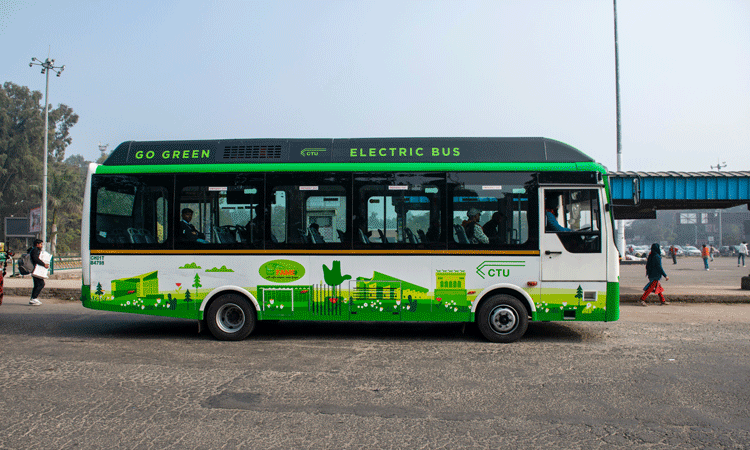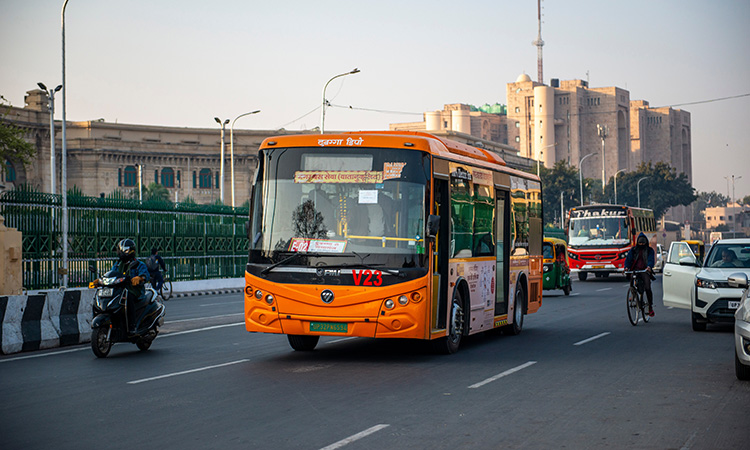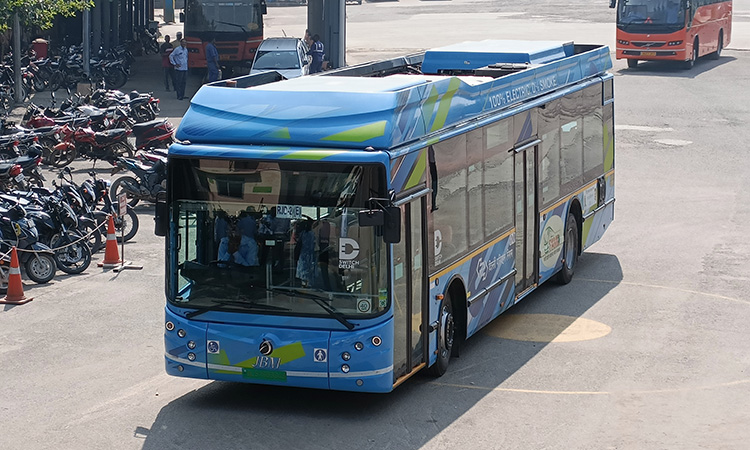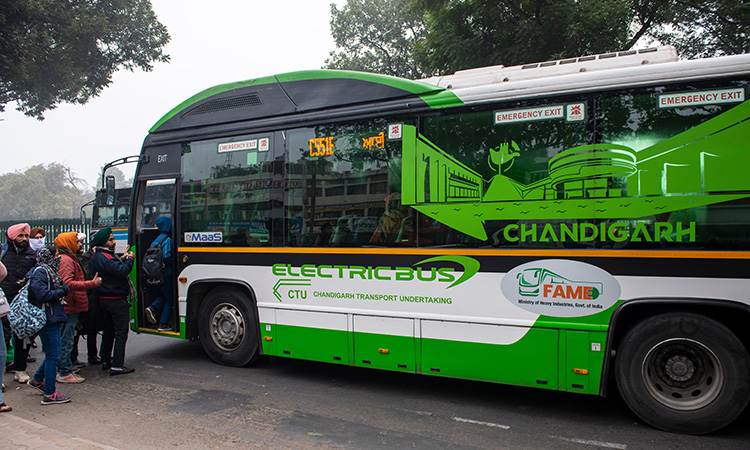India’s transition to sustainable public transport: From CNG to e-mobility
- Like
- Digg
- Del
- Tumblr
- VKontakte
- Buffer
- Love This
- Odnoklassniki
- Meneame
- Blogger
- Amazon
- Yahoo Mail
- Gmail
- AOL
- Newsvine
- HackerNews
- Evernote
- MySpace
- Mail.ru
- Viadeo
- Line
- Comments
- Yummly
- SMS
- Viber
- Telegram
- Subscribe
- Skype
- Facebook Messenger
- Kakao
- LiveJournal
- Yammer
- Edgar
- Fintel
- Mix
- Instapaper
- Copy Link
Posted: 5 March 2024 | Rupa Nandy - UITP India | No comments yet
Rupa Nandy, Head of UITP India, provides valuable insight into the dynamic transformation of India’s public transportation system as it progresses towards sustainability and decarbonisation, shedding light on the multifaceted challenges and opportunities that lie ahead for the country’s rapidly evolving mobility sector.


India is amongst the fastest growing economies in the world and, lately, the most populous country across the globe. India is targeting to reach net zero carbon emissions by 2070, as per its pledge at COP26 (in Glasgow) – an enormous and ambitious task for a country with a 1.4 billion population to achieve. As per NITI Aayog’s latest report, road transportation accounts for 12% of CO2 emissions. While the contribution may seem small, the growing mobility needs of this rapidly urbanising country and energy demand could change the future scenario. It is estimated that, if not checked, the CO2 emissions from the road transport sector could double by 2050, thereby jeopardising the pathway to achieving our net zero targets.
It is estimated that, if not checked, the CO2 emissions from the road transport sector could double by 2050, thereby by jeopardising the pathway to achieving our net zero targets”
Public transport, which is a decarbonising strategy for any country, is inadequate in India. Despite the recent bus initiatives and heavy focus on metro rail across the country, if benchmarks such as per bus per thousand population is applied, it appears that India meets only one quarter of the metric.
Therefore, decarbonisation of public transportation in India was initiated due to the poor air quality in major metro cities, with Delhi being a forerunner in it.
The case of Delhi and CNG
Decarbonisation of public transportation in India was initiated due to the poor air quality in major metro cities, with Delhi being a forerunner in it”
Delhi’s compressed natural gas (CNG) programme was initiated in the late 1990s, when Public Interest Litigations were filed in the Supreme Court (SC) to control Delhi’s rising air pollution. The SC set up the Environment Pollution (Prevention and Control) Authority in 1998 and the Delhi government’s CNG programme, which had been prepared in consultation with this authority, led to the SC issuing many directives. This included the conversion of the city’s entire bus fleet to CNG, an increase in the number of CNG stations and all pre-1990 autorickshaws and taxis being ordered to convert to CNG.
In 2002, the SC imposed a fine of INR 1000 ($12) per day per diesel bus that was still on the streets in response to the Delhi government’s failure to replace diesel buses. Delhi saw its last diesel bus on the road in December 2002 and, as a result, it ended up having one of the greenest and cleanest public bus systems in the world. While the initiative was aimed at decarbonising the public bus system in the capital, it also resulted in the augmentation of an additional bus fleet for the city, thereby providing a better service.
Unfortunately, most of the other cities in the country did not follow suit and primarily remained on diesel buses.
There were other policies and initiatives that were introduced time to time, such as the National Council for Electric Mobility (NCEM) in 2011 and the National Electric Mobility Mission Plan 2020 (NEMMP) in 2013. Above all, the initiative that brought about the biggest change in the bus transportation scenario of India is the FAME Scheme that had been introduced as part of the NEMMP.


FAME era
FAME I
The Department of Heavy Industries (DHI) formulated a scheme named ‘Faster Adoption and Manufacturing of (Hybrid &) Electric Vehicles in India – FAME I’ in 2015 to promote the manufacturing of electric and hybrid vehicle technology and to ensure sustainable growth. The scheme was initially launched for a period of two years with a total fund allocation of INR 7.95 billion ($95 million). Subsequently, the scheme was extended until 31 March 2019 with an additional 20% outlay. It had four focus areas: demand creation, technology platform, pilot project and charging infrastructure.
For buses, DHI followed a framework to allocate financial incentives to cities in the form of subsidies. The subsidies were also based on a localisation component; for example, if localisation was at least 35%, then the subsidy provided would be 60% of purchase cost or 10 million INR, whichever is lower.
DHI called for an Expression of Interest (EOI) from all cities with a population of more than one million inhabitants and smaller cities which were state capitals. A total of 11 cities were finally selected, including Ahmedabad, Bangalore, Delhi, Guwahati, Hyderabad, Indore, Jaipur, Jammu, Kolkata, Lucknow and Mumbai. Nine of the 11 cities were allocated 40 buses each, while the hilly cities of Jammu and Guwahati were offered 15 buses each for subsidy. Delhi opted out of the scheme and their quota was allocated to Bangalore. Cities were allowed to choose their business model – Gross Cost Contract (GCC) or Outright Purchase (OP). In total, 425 buses were sanctioned under FAME I.
FAME II
In 2019, the Government of India approved the FAME II scheme with an outlay of INR 100 billion ($1.3 billion) for a period of three years, commencing from 1 April 2019. Approximately 35% of this funding was earmarked for buses. Out of the total funds, 86% were allocated for demand incentives to generate demand for electric vehicles (EVs) in the country. FAME II aimed to support 7,000 electric buses nationwide, and the initial screening identified 64 cities.
The first phase (2019-2021) of the scheme focused on advanced battery and registered vehicles for incentives under the scheme. At this stage, importance was given to providing affordable and environmentally friendly public transportation options for the masses and, hence, greater emphasis was placed on electric buses. Furthermore, the Model Concession Agreement was formulated at this stage and Gross Cost Contracting was the only business model mandated to receive subsidy under the scheme, with the minimum share of localisation having also been increased to 40%. There was significant variation in technical specifications and about 40% variation was seen in the prices discovered through the bidding process by various cities. In this phase, about 3,500 buses were allocated across 36 different tenders to 32 different cities between April 2019 and March 2021.


Credit: UITP India
FAME II – The grand challenge
In June 2021, Convergence Energy Services Limited (CESL), a wholly owned subsidiary of Energy Efficiency Services Limited (EESL), with its extensive experience in aggregated procurements in the energy sector, was identified as the agency best positioned to undertake national level demand aggregation for electric buses. Nine major cities were identified, each with a population of over four million in the country: Ahmedabad, Bangalore, Chennai, Delhi, Hyderabad, Kolkata, Pune and Surat.
In 2022, the Government of India announced a Performance Linked Incentives (PLI) scheme with an outlay of INR 259 billion ($5.8 billion) to incentivise EV manufacturers, component manufacturers and advanced chemistry cells, including electric bus manufacturing. The PLI scheme incentives reduced the cost of bus procurement for cities by reducing the input costs for manufacturers.
In September 2021, CESL launched the ‘Grand Challenge’ (GC) to aggregate demand for nine cities selected in phase II of FAME II in GCC model. CESL homogenised the procurement specifications across the cities based on operating conditions and contractual preferences. In response to the demand from cities, it received an aggregated demand of 5,450 electric buses from five cities, namely Bangalore, Delhi, Hyderabad, Kolkata and Surat. The number of buses eligible for subsidy in each city were allocated in proportion to their share of the aggregated demand across all cities.
The aggregated tender for these 5,450 buses included important aspects, such as payment escalation mechanism, range specifications, efficiency, depot and infrastructure readiness.
This was the largest global tender for electric bus procurement and, through a combination of economies of scale and contractual improvements, the prices discovered without subsidy are 23% to 27% lower than the current cost of diesel/ CNG buses in these cities. If the central government’s subsidy were to be included, the prices would be 31% to 35% lower.
Therefore, the results of the GC indicate a critical inflection point in India’s electric bus journey and pave the way for the rapid scaling up of electric buses in the future.
Beyond FAME
National Electric Bus Program
In 2022, the Government of India launched the ambitious National Electric Bus Program (NEBP) to improve and encourage clean fuel based public transportation. NEBP envisaged the deployment of 50,000 electric buses across the country by 2030. The programme will be run by CESL, which will aggregate demand from various cities and conduct the tender process with homogenised bus specifications to benefit from economies of scale. The programme is backed by a significant investment of INR 820 billion ($10 billion).
EV30@30
India is amongst a handful of countries that support the global EV30@30 campaign, which aims to have at least 30% of new vehicle sales be electric by 2030. However, as per a report by Niti Aayog, the sales penetration of electric buses by 2030 would be 40%. Therefore, at least a demand of 300,000 by 2030 can be foreseen.
PM Ebus Sewa Scheme
In August 2023, the PM Ebus Sewa Scheme was launched. This bus scheme aims to augment 10,000 electric buses in 169 cities in public-private partnership (PPP) model. The scheme will cover cities with a population of 300,000 and above, as per the 2011 census, including all the capital cities of Union Territories, Northeastern Region and Hill States. Under this scheme, priority will be given to cities that have no organised bus service. The scheme is estimated to cost INR 576 billion, with INR 200 billion in support provided by the central government.
The scheme will support bus operations for 10 years. This support for bus priority infrastructure will not only accelerate the proliferation of state‑of-the-art, energy efficient electric buses but also foster innovation in the e-mobility sector, as well as the development of a resilient supply chain for electric vehicles. In addition, this scheme will also bring in economies of scale for the procurement of electric buses through aggregation. The scheme anticipates a modal shift due to the increased share of bus-based public transportation, which will lead to greenhouse gas (GHG) reduction.


City level procurements
Many cities are electrifying their fleets even outside the scope of FAME and other schemes, relying on state level grants and subsidies under the state level Electric Vehicle Policy. According to a G-20 Electric Bus Report by Niti Aayog, 15 states have already notified EV policy and public transport targets; six states have notified policy without targets; three are under draft with targets; and two more with no targets are at the draft stage.
Some cities and states are conducting their own tenders and procuring electric buses as per their own business models, such as Pune, Mumbai, Delhi, Ahmedabad and Kerala. Many states and cities are expected to follow suit, either completely or partially augmenting their fleets through their own tender processes, driven by their own business model preferences.
Decarbonisation beyond conventional bus-based public transport
Decarbonisation in India is not just limited to conventional bus-based transport. There is also a substantial focus on other modes of public transport in the country”
Decarbonisation in India is not just limited to conventional bus-based transport. There is also a substantial focus on other modes of public transport in the country, such as metro rail systems, light rail systems, trolleybuses and waterborne transport. These modes of transport are inherently green and contribute significantly to achieving the decarbonisation goals of the country.
Trolleybus
A trolleybus is an electric bus that draws power from dual overhead wires using spring-loaded trolley poles – it doesn’t use a track as a path. In 2020, the Government of India created its own notification for the trolleybus system, named ‘Metro Neo’ – a solution designed for tier 2/3 cities of India to serve passengers at rates of 8,000 to 10,000 PHPDT (passenger per hour per direction). Metro Neo is being planned for cities such as Nashik, Warrangal, Bhiwadi and many more.
Metro rail
Metro rail systems that run on electricity and not fossil fuel are operational in 20 cities in India, with approximately 872km operational across Delhi and seven national capital region cities, including Bangalore, Hyderabad, Chennai, Jaipur, Kolkata, Kochi, Lucknow, Mumbai, Ahmedabad, Nagpur, Kanpur and Pune, with a ridership of 8.5 million daily. Furthermore, an additional 988km of metro rail systems, including a regional rapid transit system, is under construction in various cities.
Light Rail System
In 2019, the Government of India created a notification for a Light Rail System in the country, named ‘Metrolite’, targeting smaller cities with a maximum potential of 15,000 PHPDT. These cities don’t need heavy and extensive metro networks; however, they deserve a modern public transport system that is similar to the metro. Metrolite is currently in the planning stage in many cities in India. The only city with a functional light rail system in the country is Kolkata, where the tram system remains a prominent mode of transportation. As of a 2020 report, there are currently 40 to 45 trams currently operating on seven to eight existing routes, covering a total distance of 40km.
Waterborne transport
Waterborne transport has come into the limelight again with Kochi’s water metro project. It is an integrated ferry transport system serving the Greater Kochi region in Kerala, India. It is the first integrated water transport system in India, which plans to connect Kochi’s 10 island communities with the mainland through a fleet of 78 battery‑operated electric hybrid boats, plying along 38 terminals and 16 routes spanning 76km. The system is integrated with the Kochi Metro and serves as a feeder service to the suburbs along the rivers where transport accessibility is limited. The water metro project is expected to be fully operational by 2035 and currently has seven battery operated electric boats operational and in the fleet.
Prioritising further future decarbonisation
Changing demographic patterns, increasing household incomes and increased economic activities lead to increased demand for transportation”
India is putting a lot of effort into the decarbonisation of public transportation in the country. However, India is a developing country with a high percentage of urbanisation and population load. Public transportation systems serve as a key defining element of sustainable urbanisation. Changing demographic patterns, increasing household incomes and increased economic activities lead to increased demand for transportation.
Current public transportation systems in the country are often inefficient, inadequate and, thus, are leading to increased private vehicle ownership in the country. While India has low car ownership as compared to its western counterparts, its cities are already grappling with heavy traffic, primarily from personal vehicles, posing health hazards for city dwellers.
Augmenting efficient and adequate public transportation alone is a key decarbonisation strategy for the country and would lead to a much larger impact if it is able to shift people from private vehicle ownership to mass transport systems. Decarbonisation of public transportation in the country is a novel step, as it ultimately leads to the augmentation of more and more public transportation use.
However, it’s important to note that decarbonised public transportation measures and fleets are still not on par with their conventional fuel counterparts in terms of cost. Therefore, the adoption of high-cost decarbonisation measures or reservations in the adoption of new technology shouldn’t deter the planned and organic growth of public transportation in India.


Related topics
Air Quality, Infrastructure & Urban Planning, Public Transport, Sustainable Urban Transport
Issue
Issue 4 2023
Related modes
Bus & Coach
Related cities
Ahmedabad, Bangalore, Chennai, Delhi, Guwahati, Hyderabad, Indore, Jaipur, Jammu, Kanpur, Kochi, Kolkata, Lucknow, Mumbai, Nagpur, Pune, Surat
Related countries
India
Related organisations
UITP India
Related people
Rupa Nandy







